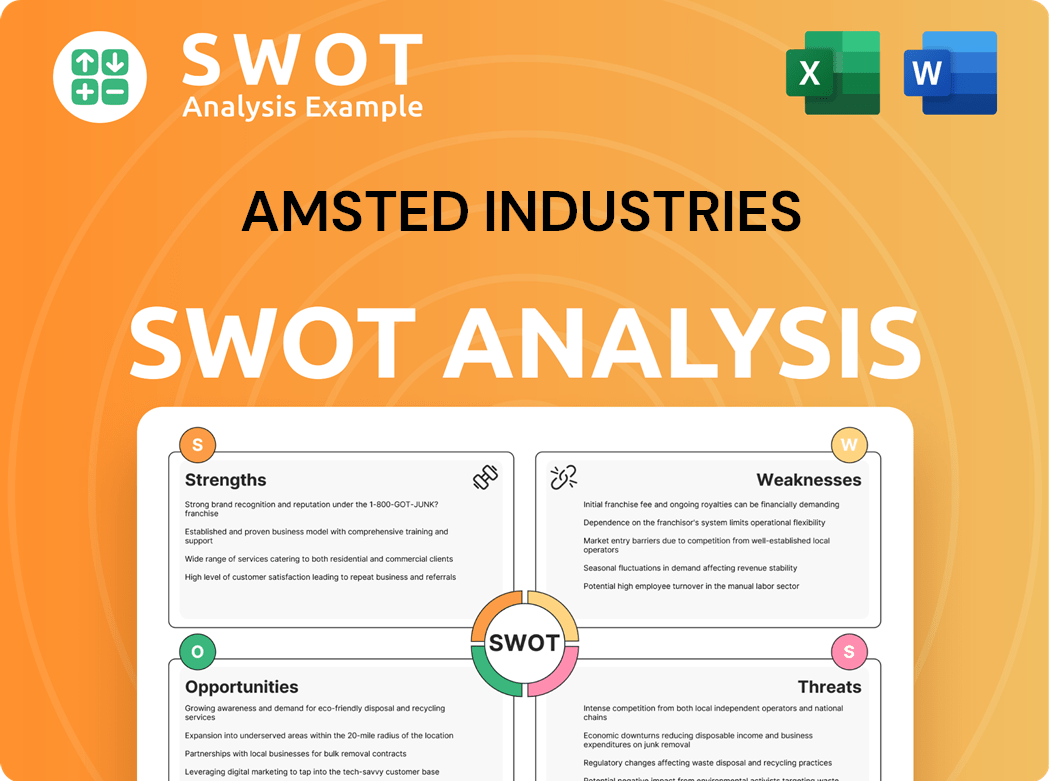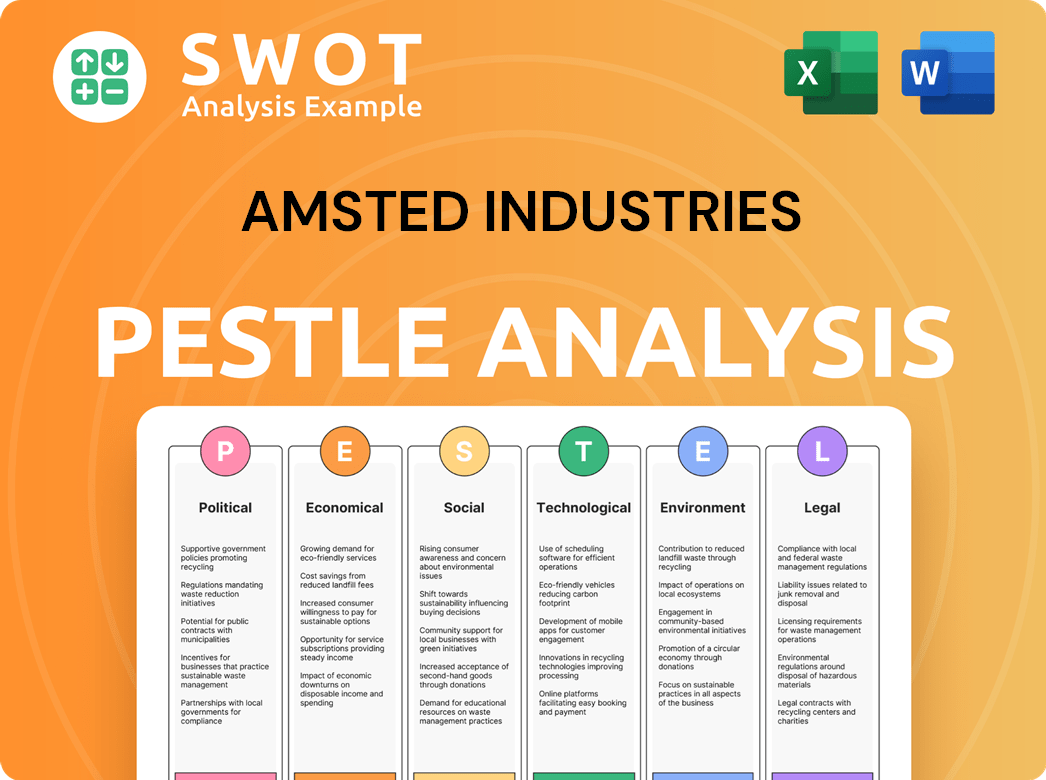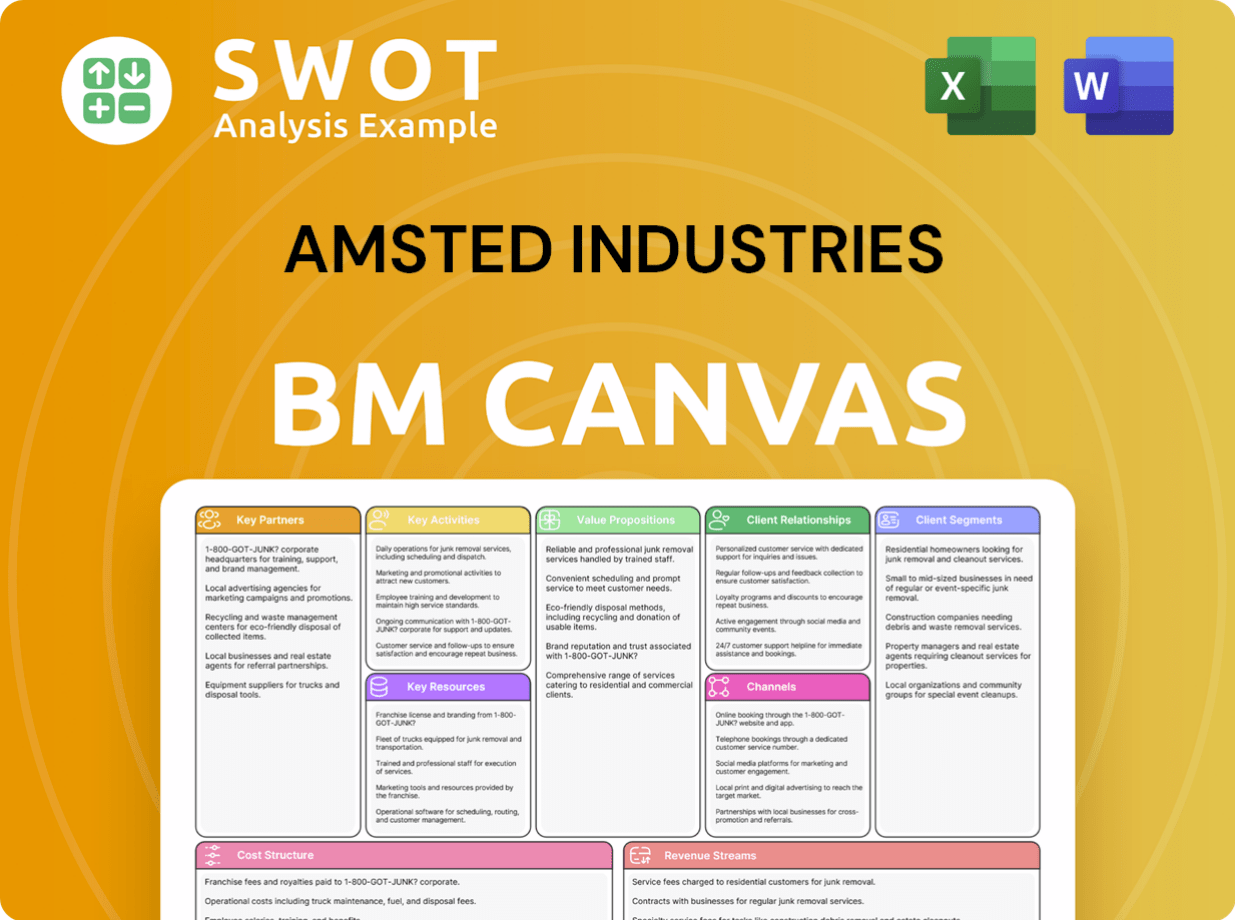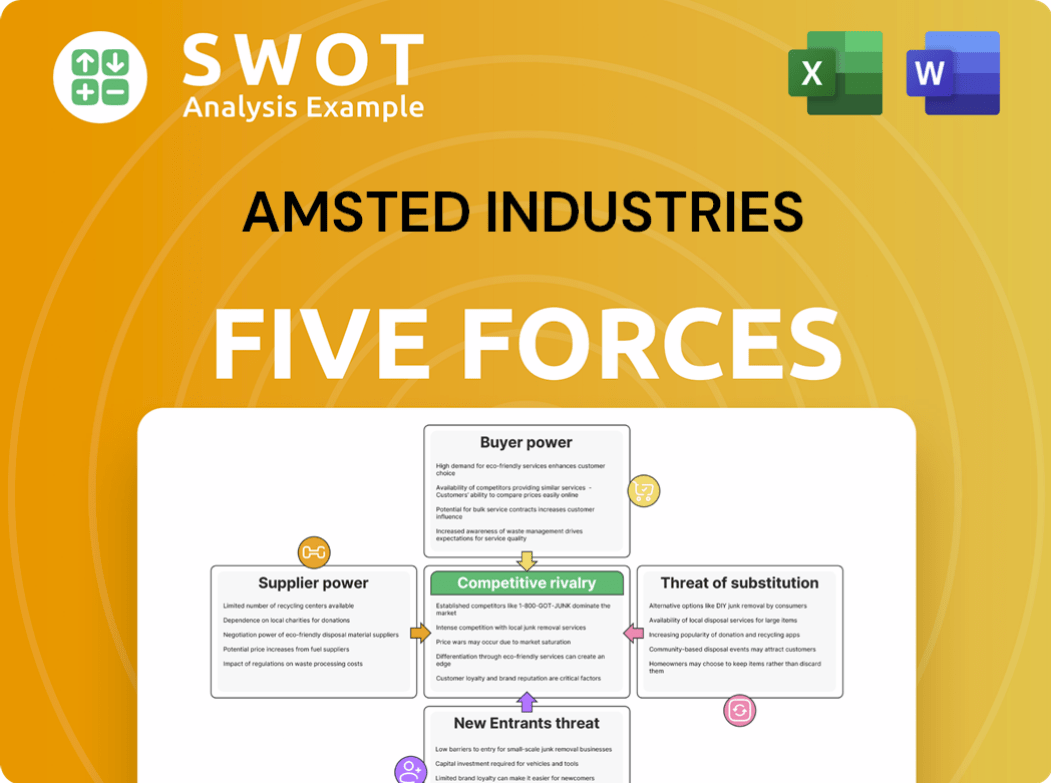Amsted Industries Bundle
Who Buys from Amsted Industries?
Understanding the customer base is crucial for any company's success. For Amsted Industries, a deep dive into its Amsted Industries SWOT Analysis reveals the importance of knowing its customers. This analysis helps to understand the customer demographics and target market that drive the company's strategy. The insights gained from this exploration are essential for informed decision-making.

Amsted Industries' evolution from a railroad supplier to a diversified industrial manufacturer necessitates a thorough examination of its customer profile. The company's ability to adapt to its target market and understand their needs is critical for maintaining a competitive edge. This includes analyzing market segmentation and understanding the Amsted Industries customer base. By examining the customer demographics and the dynamics of the industries it serves, Amsted can refine its strategies for growth and customer satisfaction.
Who Are Amsted Industries’s Main Customers?
Understanding the customer demographics and target market of Amsted Industries is crucial for grasping its business model. As a business-to-business (B2B) supplier, the company's focus is on other businesses rather than individual consumers. This means the Amsted Industries customer profile is defined by industry, operational needs, and strategic goals of its clients.
The target market for Amsted Industries centers on several key sectors. These include the railroad industry, vehicular manufacturing, construction, and building products. The company's success hinges on its ability to meet the specific requirements of these diverse yet interconnected industries. This strategic approach allows Amsted Industries to provide specialized components and solutions.
The Amsted Industries customer base is primarily composed of large organizations. These include original equipment manufacturers (OEMs), railway operators, freight car builders, construction companies, and automotive manufacturers. These customers rely on Amsted Industries for critical components that ensure safety, efficiency, and durability in their respective operations.
Key customers include Class I railroads (e.g., Union Pacific, BNSF Railway), freight car manufacturers, and railcar leasing companies. These clients require high-performance components like railcar trucks and braking systems. The railroad sector remains a significant revenue driver for Amsted Industries.
Amsted Industries supplies components to automotive and heavy-duty truck manufacturers. These components include bearings and springs. This segment supports the production of commercial vehicles and specialized transportation equipment.
This segment involves supplying components for infrastructure projects and residential/commercial construction. Amsted provides structural components and specialized plastic products. This diversification helps mitigate cyclicality in the rail industry.
Demand for Amsted's products is driven by intermodal freight transportation and infrastructure development. The company's strategic diversification into vehicular, construction, and building products has led to growth. This diversification helps to balance the cyclical nature of the rail industry.
The Amsted Industries target market analysis reveals a focus on several key segments. These include railroads, vehicular manufacturing, construction, and building products. The company strategically serves these sectors to ensure sustainable growth.
- Railroads: Class I railroads, freight car manufacturers, and railcar leasing companies are primary customers.
- Vehicular: Automotive and heavy-duty truck manufacturers rely on Amsted's components.
- Construction and Building Products: Infrastructure projects and residential/commercial construction firms.
- Strategic Diversification: Expanding into new sectors mitigates risks and leverages expertise.
To gain a broader understanding of the company's history and evolution, consider reading the Brief History of Amsted Industries. This provides valuable context for the company's strategic decisions and customer relationships.
Amsted Industries SWOT Analysis
- Complete SWOT Breakdown
- Fully Customizable
- Editable in Excel & Word
- Professional Formatting
- Investor-Ready Format

What Do Amsted Industries’s Customers Want?
Understanding the customer needs and preferences is crucial for any business, and for Amsted Industries, this means focusing on its B2B clientele. The company's success hinges on meeting the specific demands of industries like rail transport and construction, where reliability and operational efficiency are paramount. This customer-centric approach drives product development and marketing strategies.
The customer demographics of Amsted Industries are primarily comprised of businesses operating in heavy industries. These customers are not just looking for products; they are seeking solutions that enhance their operational performance and reduce risks. Their preferences are shaped by the need for durable, high-quality components that comply with strict industry standards.
Amsted Industries' target market analysis reveals a focus on long-term value and performance. The company's customer profile includes entities that prioritize reliability, safety, and cost-effectiveness. By understanding these factors, Amsted Industries can tailor its offerings to meet and exceed customer expectations.
Amsted Industries' customers, which include major players in the rail and construction sectors, have specific needs and preferences that drive their purchasing decisions. These are centered on operational efficiency, reliability, and cost-effectiveness. These needs influence Amsted's product development and customer relationship management strategies.
- Operational Efficiency: Customers seek components that minimize downtime and maximize productivity. For example, in the rail industry, reducing the frequency of maintenance and extending the lifespan of components like bearings is critical.
- Reliability and Safety: Given the critical nature of the components, customers prioritize suppliers who can guarantee high-quality and safe products. Component failure can lead to significant financial losses and safety hazards.
- Cost-Effectiveness: Customers are always looking for solutions that offer the best value. This includes not only the initial cost but also the long-term operating costs, such as maintenance and energy consumption.
- Compliance and Standards: Adherence to industry standards, like those set by the Association of American Railroads (AAR), is essential for rail components.
- Supplier Reputation and Support: Customers value suppliers with a strong reputation for quality, reliability, and excellent after-sales support. This includes technical assistance and responsive customer service.
Amsted Industries PESTLE Analysis
- Covers All 6 PESTLE Categories
- No Research Needed – Save Hours of Work
- Built by Experts, Trusted by Consultants
- Instant Download, Ready to Use
- 100% Editable, Fully Customizable

Where does Amsted Industries operate?
The geographical market presence of Amsted Industries is extensive, with a significant footprint across North America, Europe, and Asia. The company strategically positions itself in key industrial regions to serve its diverse customer base. This global approach allows for responsiveness to local market demands and leverages opportunities for growth.
Historically, the company has a strong presence in North America, particularly within the railroad industry. However, it has expanded its operations internationally to capitalize on global infrastructure development and industrial expansion. This strategic expansion includes manufacturing facilities and sales offices in key regions, supporting customer service and product customization.
The company's market segmentation strategy focuses on adapting its offerings to meet the specific needs of different regions. This approach involves tailoring products to regional standards, customer preferences, and regulatory environments. Strategic partnerships and joint ventures are also used to navigate diverse market landscapes and strengthen its competitive position.
North America remains a core market, especially within the railroad sector. Competitors Landscape of Amsted Industries shows that the company has a strong brand recognition here. The extensive rail network and robust freight operations in the United States and Canada support a significant customer base.
In Europe, the company serves both rail and industrial markets, adapting its offerings to regional standards. This includes compliance with local regulations and providing tailored product variations to meet specific customer needs. The market is mature but stable.
Asia, particularly China and India, represents a growing market due to substantial investments in railway infrastructure, automotive manufacturing, and construction. The company focuses on expanding its customer base in this region.
The company also has a presence in South America and other key industrial regions. These markets contribute to a diversified portfolio, with increasing growth in emerging economies. The geographic distribution of sales reflects this diversified approach.
The company's customer demographics vary across regions, with differences in technological adoption, regulatory environments, and economic development influencing customer preferences. Amsted Industries' customer segmentation strategies involve localized approaches, including manufacturing facilities and sales offices in key regions, to ensure responsive customer service and compliance with local regulations. The company's focus on customer relationship management is crucial for maintaining its market share and driving future growth. The company's market share by customer segment reflects its diversified portfolio, with strong performance in mature markets like North America and Europe, complemented by increasing growth in emerging economies within Asia and South America.
Amsted Industries Business Model Canvas
- Complete 9-Block Business Model Canvas
- Effortlessly Communicate Your Business Strategy
- Investor-Ready BMC Format
- 100% Editable and Customizable
- Clear and Structured Layout

How Does Amsted Industries Win & Keep Customers?
Customer acquisition and retention strategies for a company like Amsted Industries are primarily focused on building strong, long-term relationships within the business-to-business (B2B) sector. The company, known for its engineering expertise, prioritizes direct engagement and customized solutions for its industrial clients. Understanding the Owners & Shareholders of Amsted Industries is key to grasping the company's customer-centric approach.
The approach emphasizes direct sales, often involving dedicated teams and technical specialists who work closely with clients. Industry events and publications also play a role in showcasing new products and networking. The company's reputation for quality and reliability is a cornerstone of its acquisition strategy, which often involves competitive bidding and demonstrating superior product performance.
Customer retention is crucial, focusing on consistent product quality, reliable delivery, and proactive after-sales service. This includes technical support, maintenance advice, and readily available spare parts. The emphasis is on building trust and becoming a strategic partner to clients, fostering loyalty through personalized service and continuous innovation. Although specific customer relationship management (CRM) systems or segmentation strategies aren't publicly detailed, a large B2B enterprise like this would likely use internal systems to manage customer interactions and track project progress, impacting the lifetime value of customers.
Customer acquisition relies heavily on the company's established reputation for quality. New business is often secured through competitive bidding and demonstrating superior product performance. The sales process involves extensive technical consultations and collaboration with clients' engineering and procurement teams. The focus is on providing customized engineered solutions to address specific client challenges.
Customer retention is paramount, achieved through consistent product quality, reliable delivery, and proactive after-sales service. This includes technical support, maintenance advice, and spare parts availability. The company focuses on building trust and becoming a strategic partner. Personalized service, responsiveness to feedback, and continuous innovation are key.
Direct sales teams are a primary channel, engaging directly with key decision-makers. Industry trade shows, conferences, and specialized publications are crucial platforms for showcasing products and networking. Competitive bidding and demonstrating superior product performance are also key acquisition methods.
Loyalty is fostered through personalized service and responsiveness to customer feedback. Consistent product quality and reliable delivery are foundational. Continuous innovation to provide added value and building long-term partnerships are also important.
Dedicated sales teams and technical specialists work closely with clients. This direct engagement facilitates understanding specific needs and offering tailored solutions. This hands-on approach ensures a high level of customer service and support.
Trade shows and conferences are used to showcase new products and capabilities. These events provide opportunities to network with potential and existing customers. They also allow the company to stay current with industry trends.
The company's reputation is built on producing high-quality, durable, and reliable industrial components. This reputation is a key driver for attracting new customers. It also supports customer retention through consistent performance.
Proactive after-sales service includes technical support, maintenance advice, and spare parts availability. This ensures customers can rely on the company for ongoing support. It also builds trust and strengthens relationships.
Offering customized engineered solutions addresses specific client challenges. This approach provides added value and strengthens customer relationships. It differentiates the company from competitors.
Customer data, related to product usage and service history, helps understanding customer needs. This data informs future interactions and enhances service quality. Customer relationship management is critical.
Amsted Industries Porter's Five Forces Analysis
- Covers All 5 Competitive Forces in Detail
- Structured for Consultants, Students, and Founders
- 100% Editable in Microsoft Word & Excel
- Instant Digital Download – Use Immediately
- Compatible with Mac & PC – Fully Unlocked

Related Blogs
- What are Mission Vision & Core Values of Amsted Industries Company?
- What is Competitive Landscape of Amsted Industries Company?
- What is Growth Strategy and Future Prospects of Amsted Industries Company?
- How Does Amsted Industries Company Work?
- What is Sales and Marketing Strategy of Amsted Industries Company?
- What is Brief History of Amsted Industries Company?
- Who Owns Amsted Industries Company?
Disclaimer
All information, articles, and product details provided on this website are for general informational and educational purposes only. We do not claim any ownership over, nor do we intend to infringe upon, any trademarks, copyrights, logos, brand names, or other intellectual property mentioned or depicted on this site. Such intellectual property remains the property of its respective owners, and any references here are made solely for identification or informational purposes, without implying any affiliation, endorsement, or partnership.
We make no representations or warranties, express or implied, regarding the accuracy, completeness, or suitability of any content or products presented. Nothing on this website should be construed as legal, tax, investment, financial, medical, or other professional advice. In addition, no part of this site—including articles or product references—constitutes a solicitation, recommendation, endorsement, advertisement, or offer to buy or sell any securities, franchises, or other financial instruments, particularly in jurisdictions where such activity would be unlawful.
All content is of a general nature and may not address the specific circumstances of any individual or entity. It is not a substitute for professional advice or services. Any actions you take based on the information provided here are strictly at your own risk. You accept full responsibility for any decisions or outcomes arising from your use of this website and agree to release us from any liability in connection with your use of, or reliance upon, the content or products found herein.